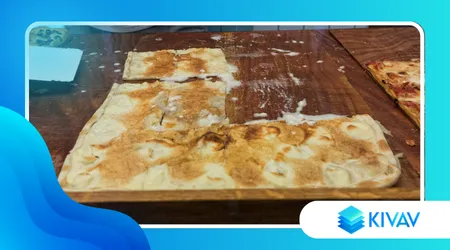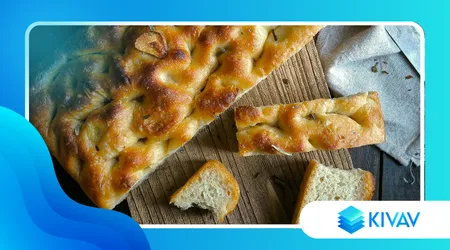Recco-Style Cheese Focaccia
There Recco-style cheese focaccia It is not simply a dish, but an experience that embodies the tradition, simplicity, and excellence of Ligurian cuisine.
Announcements
This gastronomic treasure, originating from the picturesque town of Recco, Liguria, represents a perfect combination of minimal ingredients and intense flavors.
But what makes this focaccia so special?
Is it just a matter of taste or is there something deeper that elevates it to a cultural symbol?
Recco-Style Cheese Focaccia

There focaccia Recco-type cheese is distinguished by its uniqueness: two very thin layers of unleavened dough enclosing a stringy heart of cheese, usually crescenza or stracchino.
Announcements
Unlike other focaccias, such as the Genoese one, it does not need to rise, which makes it a quick dish to prepare, but it requires absolute mastery to achieve perfection.
Furthermore, its Protected Geographical Indication (PGI) guarantees authenticity and quality, protecting a tradition that dates back centuries.
This recognition is not just a brand, but a promise of respect for the roots of a dish that tells the story of a community.
Imagine a blank canvas, ready to be painted with flavors: that's what Recco-style cheese focaccia is. Like a work of art, it requires balance, precision, and passion.
Each bite is a sensory journey, where the crunchiness of the crust marries the creaminess of the melted cheese, creating a contrast that delights the palate.
However, its simplicity is deceptive: behind every perfect focaccia lies a craftsmanship that few masters know how to perform.
++ Homemade bread with a crispy crust
Let's discover together how this seemingly humble dish has become an icon of Italian gastronomy.
The History of Recco-Style Cheese Focaccia

There Recco-style cheese focaccia It has its roots in the Middle Ages, when the fishermen and farmers of Recco were looking for a nutritious but simple meal to prepare.
In an era when ingredients were scarce, creativity was key.
Focaccia, with its base of flour, water, oil, and salt, filled with local cheeses, represented an ideal solution.
Not surprisingly, it is said that it was the food of religious festivals, offered as thanksgiving during celebrations.
This connection with sacred tradition adds an aura of mysticism to the dish, making it not just a food, but a symbol of sharing.
Over the centuries, Recco-style cheese focaccia has evolved, but without losing its essence.
In the 20th century, the town of Recco began promoting it as a local specialty, attracting the attention of gourmets and tourists. In 2011, the European Union granted it PGI status, a recognition that consolidated its status.
According to statistics from the Focaccia di Recco Consortium, approximately 500,000 portions of cheese focaccia are produced each year in Liguria alone, a number that testifies to its popularity and role in regional culture.
Think of Recco-style cheese focaccia as a poem: each line (or layer) is essential, but it's the whole that creates the harmony.
His story is not just a chronicle of ingredients, but a narrative of resilience and identity.
Today, Recco's restaurants and bakeries, like the famous "Manuelina," continue to preserve this tradition, while innovative chefs reinterpret it, keeping alive a legacy that speaks of sea, sun, and simplicity.
How to Make Authentic Recco-Style Cheese Focaccia

Prepare a Recco-style cheese focaccia It requires more than a recipe: it is an act of devotion.
The base is made with type “00” flour, water, extra virgin olive oil and a pinch of salt.
The dough must be worked until it becomes smooth and elastic, but the real challenge is rolling it out into very thin, almost transparent layers.
This process, which requires experience, is what distinguishes a mediocre focaccia from an extraordinary one.
Once rolled out, the first layer is placed on a greased baking tray, ready to receive the cheese.
The cheese, usually crescenza, is the heart of the focaccia. It should be soft, creamy, and slightly acidic, balancing the crunchiness of the crust.
After distributing the cheese into cubes, cover with a second layer of pasta, sealing the edges carefully.
Before baking, make small holes in the surface to prevent the steam from puffing up the focaccia, and finish with a drizzle of oil.
Cooking, at high temperatures (around 300°C), is brief but crucial: in 8-10 minutes, the focaccia must brown without losing its internal moisture.
To give you an idea, preparing it is like composing a symphony: every movement must be precise, but the result is a harmony of flavors.
An original example?
Try replacing some of the crescenza with a soft goat cheese for a bolder touch, while still maintaining the authenticity of the dish.
Another experiment could be adding a pinch of white pepper to the mixture to enhance the flavor without overpowering it.
These little tricks, always respecting tradition, can make your focaccia unique.
Table: Ingredients for a Recco-Style Cheese Focaccia (4 people)
| Ingredient | Amount | Notes |
|---|---|---|
| “00” flour | 500 g | Preferably low in gluten |
| Waterfall | 250 ml | Warm, to help the dough rise |
| EVO oil | 50 ml | Ligurian, for authenticity |
| Salt | 10 g | Fine, for a balanced taste |
| Growth | 400 g | Oh stracchino, fresh and soft |
The Secrets to a Perfect Focaccia
The perfection of the Recco-style cheese focaccia it's in the details.
First and foremost, the quality of the ingredients: the flour must be fine, and the oil strictly extra virgin, preferably Ligurian, for its fruity flavor. The cheese, then, is a whole other story.
The crescenza must be fresh, with a consistency that melts in the mouth without being too liquid.
A common mistake is using overly mature cheeses, which compromise the dish's typical creaminess.
Another secret is the oven temperature. Traditionally, focaccia is baked in wood-fired ovens, which reach extremely high temperatures, ensuring a crispy crust and a soft interior.
At home, an electric or gas oven should be preheated to maximum, and the baking tray should be made of thin metal to conduct heat evenly.
Also, don't underestimate the importance of rolling out the dough: it should be so thin it feels like tissue paper, but without tearing.
This takes patience and practice.
Finally, context matters.
Serving freshly baked Recco-style cheese focaccia with a glass of Ligurian Vermentino elevates the experience to another level.
An original example could be pairing it with a light sauce of raw tomato and basil, to be served on the side, for a touch of freshness.
Focaccia isn't just food, it's a moment of conviviality: share it with friends, breaking it with your hands, and let the melted cheese do the rest.
Table: Common Mistakes and Solutions in Preparation
| Mistake | Cause | Solution |
|---|---|---|
| Dough too thick | Uneven spreading | Use a rolling pin and work on an oiled surface |
| Cheese coming out | Poor sealing | Press the edges well and make holes on the surface |
| Soft crust | Low oven temperature | Preheat to 300°C and use a thin baking tray |
The Cultural and Gastronomic Importance
There Recco-style cheese focaccia It's not just a dish, but an ambassador of Liguria in the world.
Its Protected Geographical Indication protects not just a recipe, but an entire community that has turned simplicity into an art.
Every year in Recco, the “Festa della Focaccia” is celebrated, an event that attracts thousands of visitors eager to taste this delicacy.
This demonstrates how a dish can become a symbol of identity, capable of uniting generations.
Furthermore, Recco-style cheese focaccia fits into a gastronomic landscape in which Italian cuisine stands out for its ability to transform simple ingredients into masterpieces.
Compared to other focaccias, such as those from Genoa or Bari, the Recco version stands out for its immediacy: it doesn't require long leavening or complex toppings.
This makes it a versatile dish, perfect as an appetizer, snack, or main course, depending on the occasion.
What if we told you that Recco-style cheese focaccia is like a warm hug on a rainy day?
It is comfort food in its purest form, but with an elegance that makes it suitable for any context.
Whether served in a seaside trattoria or a Michelin-starred restaurant, it retains its authenticity, speaking directly to the heart of those who taste it.
Isn't this the true power of cooking?
Frequently Asked Questions
| Request | Answer |
|---|---|
| What's the difference between focaccia di Recco and focaccia genovese? | Recco focaccia is unleavened, filled with cheese, and has a crispy, stringy texture. Genovese is leavened, soft, and often seasoned with oil and coarse salt. |
| Can I use a cheese other than crescenza? | Yes, but choose a soft, creamy cheese, such as stracchino or a fresh goat cheese, to maintain the traditional consistency. |
| How long does Recco-style cheese focaccia keep? | It's best eaten fresh from the oven. If necessary, refrigerate it for a day and reheat it in the oven before serving. |
| Can I make it without a wood-fired oven? | Absolutely! A home oven at 300°C with a thin baking sheet works well, although a wood-fired oven adds a unique aroma. |
Conclusion
There Recco-style cheese focaccia It's much more than a dish: it's a story, an art, a symbol of a land that knows how to transform simplicity into excellence.
With its crunchy crust, its stringy heart and its history rich in tradition, it represents an experience that goes beyond taste.
Whether you're in a trattoria in Recco or in your own kitchen, preparing and enjoying this focaccia is an act of love for Italian cuisine.
So, why not try making it your own?
With just a few ingredients and a lot of passion, you could discover a new way to celebrate Liguria, one bite at a time.
